(完整版)一般现在时与现在进行时的区别
(完整版)一般现在时和现在进行时的区别
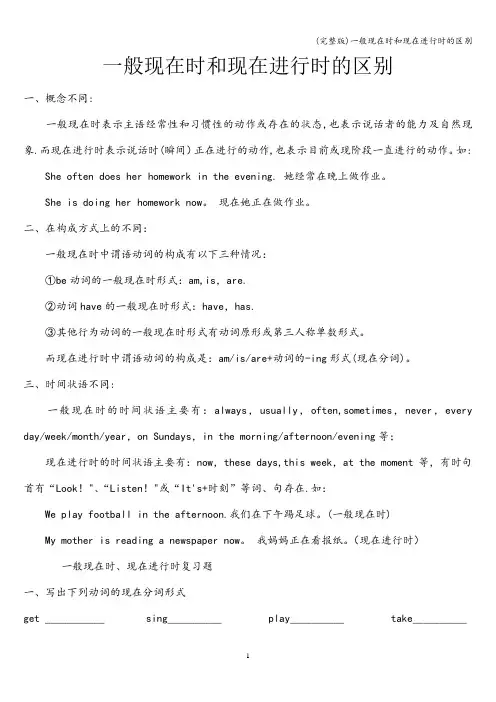
一般现在时和现在进行时的区别一、概念不同:一般现在时表示主语经常性和习惯性的动作或存在的状态,也表示说话者的能力及自然现象.而现在进行时表示说话时(瞬间)正在进行的动作,也表示目前或现阶段一直进行的动作。
如: She often does her homework in the evening. 她经常在晚上做作业。
She is doing her homework now。
现在她正在做作业。
二、在构成方式上的不同:一般现在时中谓语动词的构成有以下三种情况:①be动词的一般现在时形式:am,is,are.②动词have的一般现在时形式:have,has.③其他行为动词的一般现在时形式有动词原形或第三人称单数形式。
而现在进行时中谓语动词的构成是:am/is/are+动词的-ing形式(现在分词)。
三、时间状语不同:一般现在时的时间状语主要有:always,usually,often,sometimes,never,every day/week/month/year,on Sundays,in the morning/afternoon/evening等;现在进行时的时间状语主要有:now,these days,this week,at the moment等,有时句首有“Look!"、“Listen!"或“It's+时刻”等词、句存在.如:We play football in the afternoon.我们在下午踢足球。
(一般现在时)My mother is reading a newspaper now。
我妈妈正在看报纸。
(现在进行时)一般现在时、现在进行时复习题一、写出下列动词的现在分词形式get ___________ sing__________ play__________ take__________study_________ dance_________ have__________ write__________ run___________ sit___________ shop__________ swim__________二、写出下列动词的第三人称单数形式work__________ read__________ clean__________ write__________teach__________ wash__________ guess__________ watch__________go____________ do___________ photo__________ study__________fly__________ cry__________ play_________ have__________三、用动词的适当形式填空1. She ______________ (go) to school at eight o'clock。
一般现在时与现在进行时的区别
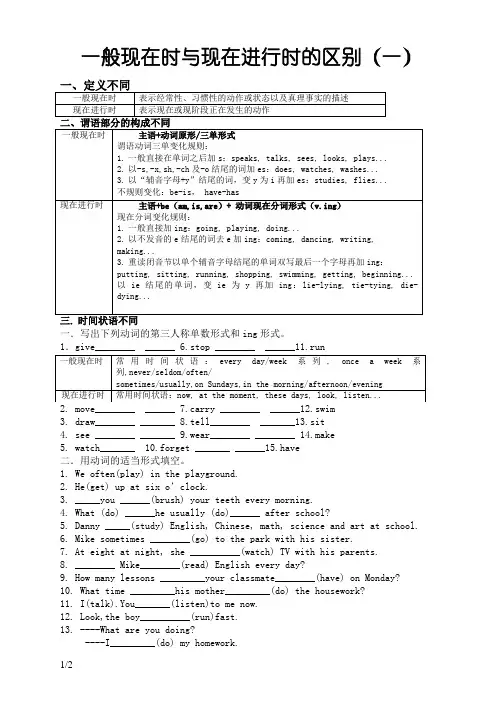
一般现在时与现在进行时的区别(一)一.写出下列动词的第三人称单数形式和ing形式。
1.give________ ______ 6.stop ________ ______11.run3. draw________ _______ 8.tell________ _______13.sit4. see ________ _______ 9.wear________ ________ 14.make5. watch_______ 10.forget _______ ______15.have二.用动词的适当形式填空。
1. We often(play) in the playground.2. He(get) up at six o’clock.3. _____you ______(brush) your teeth every morning.4. What (do) ______he usually (do)______ after school?5. Danny _____(study) English, Chinese, math, science and art at school.6. Mike sometimes ________(go) to the park with his sister.7. At eight at night, she __________(watch) TV with his parents.8. ________ Mike________(read) English every day?9. How many lessons _________your classmate________(have) on Monday?10. What time _________his mother_________(do) the housework?11. I(talk).You_______(listen)to me now.12. Look,the boy__________(run)fast.13. ----What are you doing?----I_________(do) my homework.14. ----_______the students_______(read) English.----Yes,they are.15. Tom_______(not study)English.He is studying Chinese.16. ----Who_______(sing)a song now?----Li Ying is.17. The girl_______(not eat)bananas now.18. ----Where____they(stand)?----They are standing over there.19. Look! The boy over there_______(play) a model plane.20. ----What is Meimei doing now?----She(watch)TV with her parents三.按照要求该写句子1.Ido my homework every day.否定句:一般疑问句:特殊疑问句(对划线部分提问):2.Daniel watches TVevery evening.否定句:一般疑问句:特殊疑问句(对划线部分提问):3.I’m playing football on the playground .否定句:一般疑问句:特殊疑问句(对划线部分提问):4.Tom is reading booksin his study room .否定句:一般疑问句:特殊疑问句(对划线部分提问):。
现在进行时与一般现在时的区别
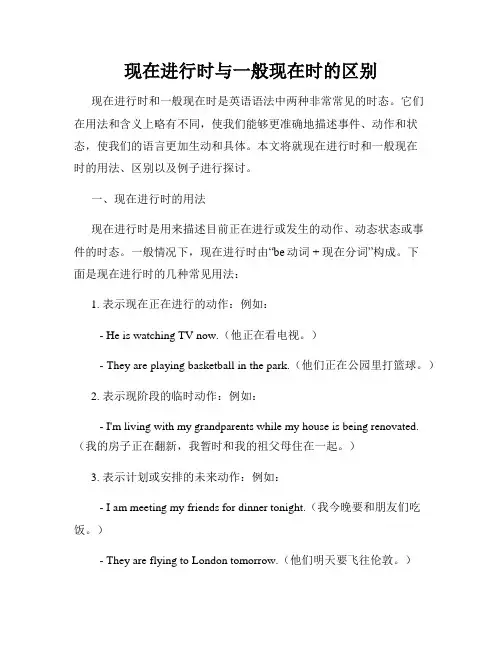
现在进行时与一般现在时的区别现在进行时和一般现在时是英语语法中两种非常常见的时态。
它们在用法和含义上略有不同,使我们能够更准确地描述事件、动作和状态,使我们的语言更加生动和具体。
本文将就现在进行时和一般现在时的用法、区别以及例子进行探讨。
一、现在进行时的用法现在进行时是用来描述目前正在进行或发生的动作、动态状态或事件的时态。
一般情况下,现在进行时由“be动词 + 现在分词”构成。
下面是现在进行时的几种常见用法:1. 表示现在正在进行的动作:例如:- He is watching TV now.(他正在看电视。
)- They are playing basketball in the park.(他们正在公园里打篮球。
)2. 表示现阶段的临时动作:例如:- I'm living with my grandparents while my house is being renovated.(我的房子正在翻新,我暂时和我的祖父母住在一起。
)3. 表示计划或安排的未来动作:例如:- I am meeting my friends for dinner tonight.(我今晚要和朋友们吃饭。
)- They are flying to London tomorrow.(他们明天要飞往伦敦。
)二、一般现在时的用法一般现在时是用来描述经常、习惯性发生的动作或状态的时态。
一般情况下,一般现在时使用动词的原形。
下面是一般现在时的几种常见用法:1. 表示经常性或习惯性的动作:例如:- She drinks a cup of tea every morning.(她每天早上喝一杯茶。
) - They often go shopping on weekends.(他们经常在周末去购物。
)2. 表示普遍真理或客观事实:例如:- The sun rises in the east and sets in the west.(太阳从东方升起,从西方落下。
一般现在时与现在进行时的区别
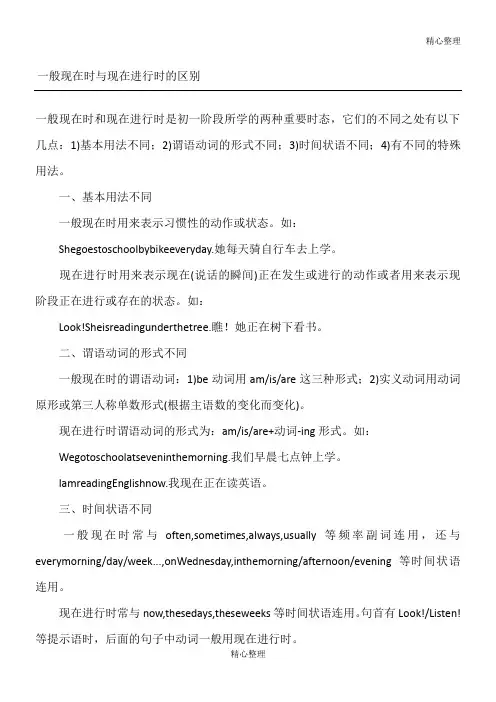
精心整理一般现在时与现在进行时的区别一般现在时和现在进行时是初一阶段所学的两种重要时态,它们的不同之处有以下几点:1)基本用法不同;2)谓语动词的形式不同;3)时间状语不同;4)有不同的特殊用法。
一般现在时常与often,sometimes,always,usually等频率副词连用,还与everymorning/day/week...,onWednesday,inthemorning/afternoon/evening等时间状语连用。
现在进行时常与now,thesedays,theseweeks等时间状语连用。
句首有Look!/Listen!等提示语时,后面的句子中动词一般用现在进行时。
四、特殊用法不同1.一般现在时的特殊用法:表示客观真理、自然现象往往要用一般现在时表示。
如:Themoongoesroundtheearth.月亮绕着地球转。
2.现在进行时的特殊用法:hear、smell、taste、feel、notice、agree、believe、like、hate、want、think、belongseem等。
如:Iknowwhatyoumean.Smithownsacarandahouse.AllthestudentsherebelongtoNo.1MiddleSchool.4少数用于表示起止的动词如come、go、leave、arrive、fly、return、start、begin、pen、close、end、stop等常用一般现在时代替将来时,表示一个按规定、计划或安排要发生的动作。
当be表示根据时间或事先安排,肯定会出现的状态,只用一般现在时。
Theshopclosesat11:00p.m.everyday.②下作:状态的动词:appear,exist,lie,remain,seembelongto,dependon。
(C)表示一时性动作的动词:allow,accept,permit,promise,admit,complete。
一般现在时与现在进行时的区别
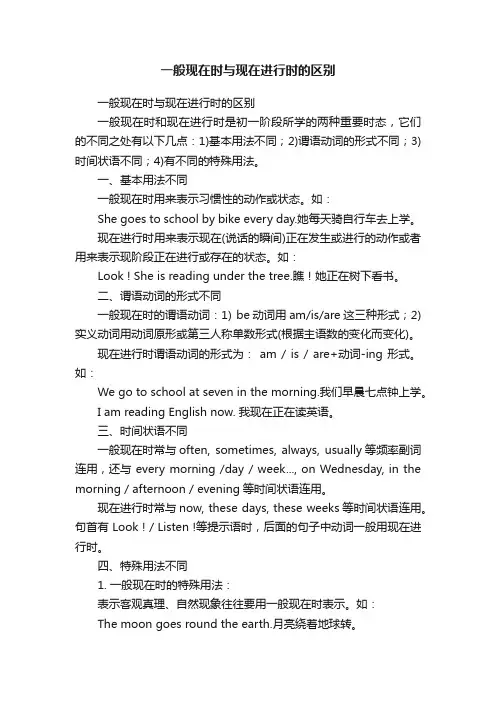
一般现在时与现在进行时的区别一般现在时与现在进行时的区别一般现在时和现在进行时是初一阶段所学的两种重要时态,它们的不同之处有以下几点:1)基本用法不同;2)谓语动词的形式不同;3)时间状语不同;4)有不同的特殊用法。
一、基本用法不同一般现在时用来表示习惯性的动作或状态。
如:She goes to school by bike every day.她每天骑自行车去上学。
现在进行时用来表示现在(说话的瞬间)正在发生或进行的动作或者用来表示现阶段正在进行或存在的状态。
如:Look ! She is reading under the tree.瞧!她正在树下看书。
二、谓语动词的形式不同一般现在时的谓语动词:1) be动词用am/is/are这三种形式;2)实义动词用动词原形或第三人称单数形式(根据主语数的变化而变化)。
现在进行时谓语动词的形式为: am / is / are+动词-ing 形式。
如:We go to school at seven in the morning.我们早晨七点钟上学。
I am reading English now. 我现在正在读英语。
三、时间状语不同一般现在时常与often, sometimes, always, usually等频率副词连用,还与 every morning /day / week..., on Wednesday, in the morning / afternoon / evening等时间状语连用。
现在进行时常与now, these days, these weeks等时间状语连用。
句首有 Look ! / Listen !等提示语时,后面的句子中动词一般用现在进行时。
四、特殊用法不同1. 一般现在时的特殊用法:表示客观真理、自然现象往往要用一般现在时表示。
如:The moon goes round the earth.月亮绕着地球转。
2. 现在进行时的特殊用法:现在进行时与always 连用时,往往含有赞扬、厌恶、责备等感情色彩。
一般现在时和现在进行时的区别
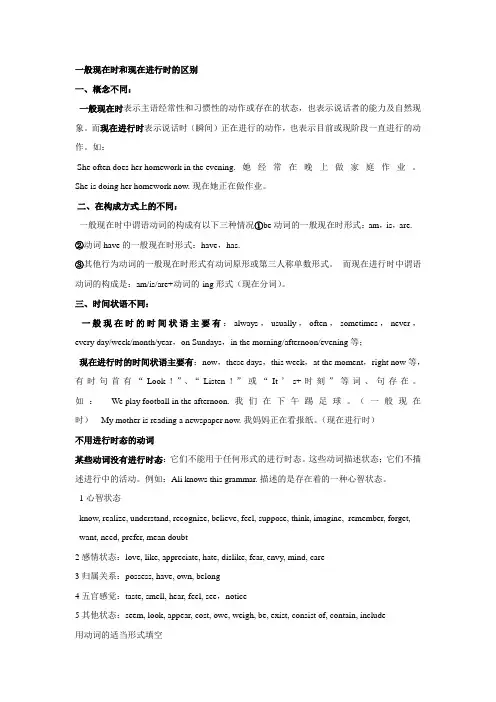
一般现在时和现在进行时的区别一、概念不同:一般现在时表示主语经常性和习惯性的动作或存在的状态,也表示说话者的能力及自然现象。
而现在进行时表示说话时(瞬间)正在进行的动作,也表示目前或现阶段一直进行的动作。
如:She often does her homework in the evening.她经常在晚上做家庭作业。
She is doing her homework now. 现在她正在做作业。
二、在构成方式上的不同:一般现在时中谓语动词的构成有以下三种情况①be动词的一般现在时形式:am,is,are.②动词have的一般现在时形式:have,has.③其他行为动词的一般现在时形式有动词原形或第三人称单数形式。
而现在进行时中谓语动词的构成是:am/is/are+动词的-ing形式(现在分词)。
三、时间状语不同:一般现在时的时间状语主要有:always,usually,often,sometimes,never,every day/week/month/year,on Sundays,in the morning/afternoon/evening等;现在进行时的时间状语主要有:now,these days,this week,at the moment,right now等,有时句首有“Look!”、“Listen!”或“It’s+时刻”等词、句存在。
如: We play football in the afternoon.我们在下午踢足球。
(一般现在时) My mother is reading a newspaper now. 我妈妈正在看报纸。
(现在进行时)不用进行时态的动词某些动词没有进行时态:它们不能用于任何形式的进行时态。
这些动词描述状态;它们不描述进行中的活动。
例如:Ali knows this grammar. 描述的是存在着的一种心智状态。
1心智状态know, realize, understand, recognize, believe, feel, suppose, think, imagine, remember, forget, want, need, prefer, mean doubt2 感情状态:love, like, appreciate, hate, dislike, fear, envy, mind, care3 归属关系:possess, have, own, belong4 五官感觉:taste, smell, hear, feel, see,notice5 其他状态:seem, look, appear, cost, owe, weigh, be, exist, consist of, contain, include用动词的适当形式填空1. She ______________ (go) to school at eight o’cl ock.2. It’s six o’clock. They _____________ (eat) supper.3. He usually ___________(get ) up at 17:00.4. She ___________ (live) in Beijing5、I (want) to do homework now.6My father always __________(come) back from work very late.7The teacher is busy. He __________ (sleep) six hours a day.8Listen! Jane __________(sing) in the classroom. She often _________ (sing) there.9__________ your brother __________(know) Japanese?10、Where __________ you __________ (have) lunch every day?11The girl _____(like) wearing a skirt. Look! She ______ __(wear) a red skirt today.12、It's time______ (go) to school13、______you______(clean)the blackboard now?14、Let's ______(go)and help her.15、What are they doing? They ___________(put)things away.16、He often _________ (have)supper at 6:00 in the evening.17 It’s 6 o’clock in the morning. He ___________.(get)up.18、Tom _________ (have) an English class now.19. I _ (read)a book in the room at the moment.20. Where _________ he _________ (come)from?21. Who ________(sing)over there now?22、Listen! The baby ________(cry) in the next room.23Look! The twins (wear)new sweaters.24、Don’t talk here. Grandparents __________ _ (sleep).25、Mrs Read _________(clean)the windows every day.26.、On Sunday he sometimes _______(wash)his clothes and sometimes ________(do) some shopping.27、The twins usually ____ (have)milk and bread for breakfast, but Jim _____ (have)some coffee for it.28---What ______ you ______ (do)? ---I _______ (make) cakes.29、Sometimes she ________ (watch) TV.30、Now she _________ (watch) TV. Jim, my good friend, ______ (be) sixteen years old.31、There ______ (be) some books and pens on the desk.32Mrs White ______ (teach) English. She ________ (teach) English now.33、---______ you ______ (make) a model plane? ---Yes, I am.34、---How ______ you ______ (like) China? ---I ______ (like) China very much。
一般现在时与现在进行时的区别
练习一一般现在时与现在进行时的区别一.定义不同一般现在时表示经常性、习惯性的动作或状态以及真理事实的描述现在进行时表示现在或现阶段正在发生的动作二.谓语部分的构成不同一般现在时动词原形或三单形式谓语动词三单变化规则:1.一般直接在单词之后加s:speaks, talks, sees, looks, plays...2.以-s,-x,sh,-ch及-o结尾的词加es:does, watches, washes...3.以“辅音字母+y”结尾的词,变y为i再加es:studies, flies... 不规则变化:be-is,have-has现在进行时be(am,is,are)+ 动词现在分词形式(v.ing)现在分词变化规则:1.一般直接加ing:going, playing, doing...2.以不发音的e结尾的词去e加ing:coming, dancing, writing, making...3.重读闭音节以单个辅音字母结尾的单词双写最后一个字母再加ing:putting, sitting, running, shopping, swimming, getting, beginning...以ie结尾的单词,变ie为y再加ing:lie-lying, tie-tying, die- dying...这些动词有一般现在时如want,like, have有,taste, sound, can---see, I think+句子-------但一般没有现在.进行时。
三.时间状语不同一般现在时常用时间状语:every day/week系列, once a week系列...现在进行时常用时间状语:now, at the moment, these days, look, listen... 试比较下列句子:I wash clothes every day.She is washing clothes.Listen! Who is singing over there? Look! Who is over there. I want to play computer games now. He is playing computer games now. Lucy is living in Chongqing.Lucy lives in Chongqing.一.写出下列动词的第三人称单数形式和ing形式。
一般现在时和现在进行时的区别
一般现在时和现在进行时的区别一般现在时表示现在的状态;表示经常的或习惯性的动作;表示主语具备的性格、能力等。
现在进行时表示现在某一时刻或某段时间正在进行的动作或存在的状态。
接下来,小编给大家准备了一般现在时和现在进行时的区别,欢迎大家参考与借鉴。
一般现在时和现在进行时的区别结构不同1. 一般现在时的结构(以肯定句为例)有以下几种形式:⑴ 动词be第一人称单数用am,第三人称单数用is,其他的一律用are。
例如:I am a student. 我是个学生。
He is an American. 他是个美国人。
They are good friends. 他们是好朋友。
⑵ 动词have除了第三人称单数用has外,其他一律用have。
例如:He has two brothers. 他有两个兄弟。
We have English classes every day. 我们每天都上英语课。
⑶ 实义动词除第三人称单数在动词原形后加-s或-es外,其他一律用动词原形。
例如:His mother works1 in a hospital. 他母亲在一家医院工作。
Children like to play this game. 孩子们喜欢玩这种游戏。
2. 现在进行时的结构为:助动词be(am/is/are)+ v-ing形式。
例如:We are singing and they are dancing. 我们在唱歌,他们在跳舞。
时间状语不同1. 一般现在时的时间状语通常为often,always,usually,sometimes,every day/week/month等。
例如:I get up at six every day. 我每天六点钟起床。
He often goes to school on foot. 他经常步行上学。
Sometimes they play football after school. 有时他们放学后踢足球。
一般现在时与现在进行时的区别
三、时间状语不同
一般现在时常与often, sometimes, always, usually等频率副词连用,还与 every morning /day / week..., on Wednesday, in the morning / afternoon / evening等时间状语连用。
The girl is always talking loud in public.(与always、often等频度副词连用,表经常反复的行动或某种感情色彩)
②下面四类动词不宜用现在进行时。(A)表示心理状态、情感的动作:like, love, hate, care, remember, believe, want, mind, wish, agree, mean, need。(B)表存在的状态的动词:appear, exist, lie, remain, seem belong to, depend on。(C)表示一时性动作的动词:allow, accept, permit, promise, admit, complete。(D)表示感官的动词:see, hear, notice, feel, smell, sound, taste, look。
习题
一.写出下列动词的第三人称单数形式。
sit swim read make run
write type go watch clean
cry wash jump come study
二.用do does填空(does 用于第三人称单数,其余用do)
1、_____ you ride a bike after school? Yes, I ________.
一般现在时和现在进行时的区别
一般现在时和现在进行时的区别一、概念不同:一般现在时表示主语经常性和习惯性的动作或存在的状态,也表示说话者的能力及自然现象。
而现在进行时表示说话时(瞬间)正在进行的动作,也表示目前或现阶段一直进行的动作。
如:She often does her homework in the evening. 她经常在晚上做作业。
She is doing her homework now. 现在她正在做作业。
二、在构成方式上的不同:一般现在时中谓语动词的构成有以下三种情况:①be动词的一般现在时形式:am,is,are.②动词have的一般现在时形式:have,has.③其他行为动词的一般现在时形式有动词原形或第三人称单数形式。
而现在进行时中谓语动词的构成是:am/is/are+动词的-ing形式(现在分词)。
三、时间状语不同:一般现在时的时间状语主要有:always,usually,often,sometimes,never,every day/week/month/year,on Sundays,in the morning/afternoon/evening等;现在进行时的时间状语主要有:now,these days,this week,at the moment等,有时句首有“Look!”、“Listen!”或“It’s+时刻”等词、句存在。
如:We play football in the afternoon.我们在下午踢足球。
(一般现在时)My mother is reading a newspaper now. 我妈妈正在看报纸。
(现在进行时)一般现在时、现在进行时复习题一、写出下列动词的现在分词形式get ___________ sing__________ play__________take__________study_________ dance_________ have__________write__________run___________ sit___________ shop__________swim__________二、写出下列动词的第三人称单数形式work__________ read__________ clean__________write__________teach__________ wash__________ guess__________ watch__________go____________ do___________ photo__________ study__________ fly__________ cry__________ play_________have__________三、用动词的适当形式填空1. She ______________ (go) to school at eight o’clock.2. It’s six o’clock. They _____________ (eat) supper.3. He usually ___________(get ) up at 17:00.4. She ___________ (live) in Beijing.5、I (want) to do homework now.6、My father always __________(come) back from work very late.7、The teacher is busy. He __________ (sleep) six hours a day.8、Listen! Jane __________(sing) in the classroom. She often _________ (sing) there.9、__________ your brother __________(know) Japanese10、Where __________ you __________ (have) lunch every day11、The girl _____(like) wearing a skirt. Look! She ______ __(wear) a red skirt today.12、It's time______ (go) to school13、______you______(clean)the blackboard now14、Let's ______(go)and help her.15、What are they doing They ___________(put)things away.16、He often _________ (have)supper at 6:00 in the evening.17、It’s 6 o’clock in the morning. He ___________.(get)up.18、Tom _________ (have) an English class now.13. Listen! The girl _____________(sing)in the room.14. I ___________(read)a book in the room at the moment.16. Where _________ he _________ (come)from17. Who ________(sing)over there now18、Listen! The baby ________(cry) in the next room.19、Look! The twins (wear)new sweaters.20、D on’t talk here. Grandparents __________ _ (sleep).21、Mrs Read _________(clean)the windows every day.22.、On Sunday he sometimes _______(wash)his clothes and sometimes ________(do)some shopping.23、The twins usually ____ (have)milk and bread for breakfast, but Jim _____ (have)some coffee for it.24、---What ______ you ______ (do) ---I _______ (make) cakes.25、Sometimes she ________ (watch) TV.26、Now she _________ (watch) TV. Jim, my good friend, ______ (be) sixteen yearsold.27、There ______ (be) some books and pens on the desk.28、Mrs White ______ (teach) English. She ________ (teach) English now.29、---______ you ______ (make) a model plane ---Yes, I am.30、---How ______ you ______ (like) China ---I ______ (like) China very much。
- 1、下载文档前请自行甄别文档内容的完整性,平台不提供额外的编辑、内容补充、找答案等附加服务。
- 2、"仅部分预览"的文档,不可在线预览部分如存在完整性等问题,可反馈申请退款(可完整预览的文档不适用该条件!)。
- 3、如文档侵犯您的权益,请联系客服反馈,我们会尽快为您处理(人工客服工作时间:9:00-18:30)。
一般现在时与现在进行时的区别
1.give________ ______ 6.stop ________ ______11.run
2. move________ ______ 7.carry ________ ______12.swim
3. draw________ _______ 8.tell ________ _______13.sit
4. see ________ _______ 9.wear________ ________ 14.make
5. watch_______ 10.forget _______ ______15.have 二.用动词的适当形式填空。
1. We often (play) in the playground.
2. He (get) up at six o’clock.
3. _____you ______(brush) your teeth every morning.
4. What (do) ______he usually (do)______ after school?
5. Danny _____(study) English, Chinese, math, science and art at school.
6. Mike sometimes ________(go) to the park with his sister.
7. At eight at night, she __________(watch) TV with his parents.
8. ________ Mike________(read) English every day?
9. How many lessons _________your classmate________(have) on Monday?
10. What time _________his mother_________(do) the housework?
11. I (talk).You_______(listen)to me now.
12. Look, the boy__________(run)fast.
13. ----What are you doing?
----I_________(do) my homework.
14. ----_______the students_______(read) English.
----Yes, they are.
15. Tom_______(not study)English. He is studying Chinese.
16. ----Who_______(sing)a song now?
----Li Ying is.
17. The girl_______(not eat)bananas now.
18. ----Where____they (stand)?
----They are standing over there.
19. Look! The boy over there_______(play) a model plane.
20. ----What is Meimei doing now?
----She (watch)TV with her parents
三.按照要求该写句子
1.I do my homework every day.
否定句:
一般疑问句:
特殊疑问句(对划线部分提问):
2.Daniel watches TV every evening.
否定句:
一般疑问句:
特殊疑问句(对划线部分提问):
3.I’m playing football on the playground .
否定句:
一般疑问句:
特殊疑问句(对划线部分提问):
4.Tom is reading books in his study room .
否定句:
一般疑问句:
特殊疑问句(对划线部分提问):。
